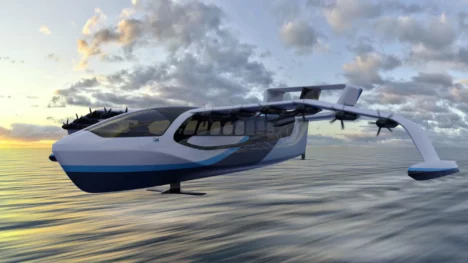Seaglider Speculation
It’s a bird. It’s a plane. It’s a hydrofoil, floating boat?
The Hawaii Seaglider Initiative made waves back in January when they proposed interisland transportation on seagliders as a reality. Now, Molokai residents and representatives are pushing for details on the project.
The seagliders are being developed by Regent, an East Coast-based company promising to deliver 100 percent electric, zero-emission, high-speed gliders, projected to be operational by 2026. With partners such as Hawaiian Airlines, Japan Airlines, and Southern Airways, Regent already has a $7.9 billion backlog for their product. Southern Airways, owner and operator of Mokulele Airlines, is slated to be the first customer worldwide to receive the seagliders, according to David Uchiyama, a community and government representative for Regent.
However, explained Uchiyama, this does not mean that Southern Airways will want to, or be able to, operate the seagliders on Molokai.
The gliders are more like floating boats than conventional planes, explained Uchiyama. The gliders will be operated out of harbors, rather than airports, using a hydrofoil to gain speed on the water before taking off. Flying at up to 180 miles per hour just 30 to 60 feet above the highest ocean swells, the gliders take advantage of a natural phenomenon called “wing-in-ground effect.”
Concerns regarding safety during high swells, marine and bird life, and environmental impacts have been just a few of the worries raised by Molokai residents. Regent is working on developing an infrared system capable of detecting birds and animals, like whales, beneath the water surface from a mile away, explained Uchiyama.
According to Uchiyama, Regent is in the process of a feasibility study, looking at potential harbor locations, traffic, dock space, and renewable energy access. This feasibility study will lead into either an environmental assessment or an environmental impact statement, which could take years to compete.
That is, if Molokai residents even want to entertain the seagliders as an option.
County Councilmember Keani Rawlins-Fernandez explained that “if it’s not something that we want here, then they’re not going to come here,” at a March 27 townhall meeting.
“We’re trying to get this worked out before the aircraft are operational,” said Uchiyama. With seagliders set to be rolled out in two years, Uchiyama believed that it could be a challenge to be prepared to accept seagliders on Molokai by then.
While there are attractive attributes of the proposed seagliders, like lower cost for travel and freight, no carbon footprint and possible alleviation from the transportation problems plaguing Molokai’s healthcare system, many Molokai residents have expressed hesitation.
Uchiyama attended the townhall meeting in the hopes of starting an early conversation with the Molokai community.
“We’re continuing to speak to everybody,” said Uchiyama. He urged Molokai residents to express concerns or support through local representatives.
The project could run out of steam before it reaches a Molokai-based decision, explained Uchiyama, if the feasibility or environmental studies don’t allow for the seagliders.
Molokai residents can learn more about Regent and the seaglider initiative at Regentcraft.com.













Don't have a Molokai Dispatch ID?
Sign up is easy. Sign up now
You must login to post a comment.
Lost Password